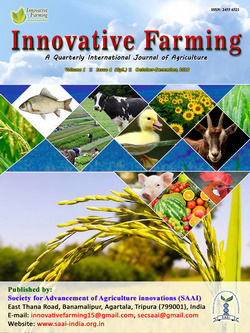
Physiologycal Studies on Silk Gland of Samia ricini (Donovan) Under Thermal Stress Condition
Runel Chandra Boro*
Department of Ecology & Environmental Sciences, Pondicherry University, Puducherry-605014, INDIA
S. Jayakumar
Department of Ecology & Environmental Sciences, Pondicherry University, Puducherry-605014, INDIA
S. Kalaimohan
Department of Ecology & Environmental Sciences, Pondicherry University, Puducherry-605014, INDIA
DOI: NIL
Keywords: Eri silk worm, Ecoraces, Silkgland, Thermal stress
Abstract
Among non-mulberry silks, only eri silk production is in increasing trend and India stands second in eri silk production. Eri silkworm, Samia ricini is domesticated and polyphagous in nature. In India most of the sericulture belt prevails in the tropical region where temperature goes 32–40 °C during the summer when compared to interior parts. Eri silkworm is poikilothermic insect, temperature will have direct effect on physiological growth and development of the silk gland. The silk gland accumulates proteins during the silkworm development and its growth is importance for the synthesis of silk proteins. The temperature required for eri silkworm is 24-28 oC and above this temperature is harmful to the growth and development of silkworm. Insects have adopted different biological and physiological strategies to overcome changes in their surrounding environment but lack of tolerance in domesticated eri silkworm may affect growth and development of silk gland and eventually silk production. Therefore, the present study was conducted under thermal stress condition (31.2 ± 1°C) to assess some important physiological parameters such as larval weight (g), silk gland weight (g),silk gland somatic index (%) and silk conversion index (%) of different ecoraces Viz. Borduar, Titabar and Mendipathar. The results show that Mendipathar eco race performed better than Borduar and Titabar ecoraces in all the parameter studied.
Downloads
not found
Reference
Biswas, N. and P.K. Das. 2001. Effect of food plant species on rearing performance of eri silkworm Samia ricini Donovan. Bull. Ind. Acad. Seri., 5: 36-38.
Chakravorty, R. and K. Neog. 2006. Food plants of eri silkworm (Samiaricini Donovan) their rearing performance and prospects for exploitation. Nation. Worksh. on eri food pla. Guw. Ind., pp 1-7.
Chen, S., S.J. Fleischer, M.C. Saunders and M.B. Thomas. 2015. The influence of diurnal temperature variation on degree-day accumulation and insect life history. Plos One, 10(3): 1-15.
Chowdhury, S.N. 2006. Host plants of eri silkworm (Samia ricini Boiduval) their distribution economic and prospects. Nation. Worksh. on eri food pla. Guw. Ind., pp 28-37.
Chhatrial, C., T.V. Rao and S. Sahoo. 2016. Silk gland somatic index and tissue biochemical contents of uv-b irradiated eri silkworm, Philosamia ricini (H.). Int. journal of plant, animal and environmental sciences, 6: 233-238.
Couret, J., E. Dotson and M.Q. Benedict. 2014. Temperature, larval diet, and density effects on development rate and survival of Aedes aegypti (Diptera: Culicidae). Plos One, 9(2):1-9.
Damos, P. and M.S. Soultani. 2012. Temperature-Driven Models for Insect Development and Vital Thermal Requirements. Hindawi Publishing Corporation Psyche, pp 1-13.
Das, D. 2015. Rearing of eri silkworm (Philosamiaricini Hutt.) on tapioca (Manihot utilisima) during autumn season in Assam. Indian journal of applied research, 5: 527-528.
Devaiah, M.C. and K.N Dayashankar. 1982. Effect of different host plants on the economc traits of eri silkworm, Samiacynthia ricini Biosduval (Lepidoptera: Saturnidae). In the proceedings Nat. Sem. Silk Res. Dev. Bang., pp 152.
Gogoi, R. and R.N.S. Yadav. 1995. Effect of host plant on some biochemical parameters of eri silkworm Philosamia ricini during its development. Ind. j. exptl. Boil., 33: 372-374.
Kumar, R. and V. Elangovan. 2010. Assessment of the volumetric attributes of eri silkworm (Philosamia ricin) reared on different host plant. Int. journal of science and nature, 1(2): 156-160.
Lemoine, N.P., D.E. Burkepile and J.D. Parker. 2014. Variable effects of temperature on insect herbivory. Peer J., 2: 1-18.
Nangia, N., P.S. jagdish and B.K.C. Nagesh. 1998. Evaluation of the volumetric attribute of the eri silkworm reard on various food plants. The third International conference on wild moth, pp 36-38.
Rahmathulla, V.K., V.B. Mathur and R.G. Geetha Devi. 2004. Growth and dietary efficiency of mulberry silkworm (Bombyx mori L.) under various nutritional and environmental stress conditions. Phi. J. Sci., 133(1): 39-43.
Sarkar, D.C. 1980. Ericulture in Inida. CSB, Bang. Ind., pp 21-23.
Sarmah, M.C, B.N. Saskar, S.A. Ahmed and J. Deuri. 2013. Eri culture- a comprehensive profile. Dire. of Seri. BTC, Kokrajhar, Assam.
Shimizu, M. 2000. Structural basis of silk fibre; in Structure of silk yarn” vol I biological and physical aspects. N. Hojo (ed.), Oxford & IBH Publication Co. Pvt. Ltd., New Delhi, pp 7-17.
Singh, T., M.M. Bhat and M.A. Khan. 2009. Insect adaptations to changing environments temperature and humidity. Int. J. Ind. Ent., 19(1): 155-164.
Sutherland, T.D., J.H. Young, S. Weisman, C.Y. Hayashi and D.J. Merritt. 2010. Insect silk: one name, many materials. Annual Review of Entomology, 55: 171-188.
